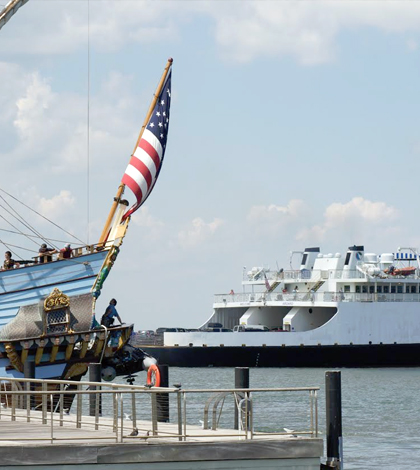Recent Study Gives Insight For Offshore Wind Development In Delaware Bay

U. Delaware researchers monitor air and water conditions in the Delaware Bay using sampling equipment aboard the Cape May-Lewes Ferry. (Credit: The University of Delaware)
One of the biggest concerns with wind power is that the amount of energy it produces varies depending on whether or not the wind is blowing. Potential for offshore wind turbines along the eastern coastline is there and, in places like Delaware, new research is giving insight on when and where the wind can be expected.
A recent study by researchers at the University of Delaware collected data using a ferry to measure the sea breeze along the Delaware Bay. Dana Veron, associate professor of geography at the university and lead author of the study, describes the sea breeze as a nice, cool wind that comes off the ocean in the evenings. But what the average beachgoer might not expect is that this gentle breeze can actually change the direction and speed of wind patterns, which can greatly influence those winds used in generating electricity.
The ferry is equipped with two mechanisms for collecting data. The first runs underwater and uses sensors to measure parameters such as temperature, pH and chlorophyll. The second is a weather vane mounted on top of the ferry that takes measurements on air pressure, humidity, and wind speed. There is also a GPS receiver that tells researchers exactly where the ferry is as it makes its way across the bay eight times throughout the day.
In analyzing the ferry measurements, Veron found that the sea breeze, specifically in Delaware Bay, is influenced by tidal phase: whether the ocean is ebbing or flowing. Under certain circumstances, there is a branch of the sea breeze that breaks off and moves directly up the axis of the bay, almost perpendicular to the coast, instead of moving inland. Veron said the tide needs to be ebbing, or within two hours of low tide, for that phenomenon to happen.

U. Delaware researchers monitor air and water conditions in the Delaware Bay using sampling equipment aboard the Cape May-Lewes Ferry. (Credit: The University of Delaware)
She also found that the breeze along New Jersey’s coast and Delaware’s coast can be very uniform but can be very sporadic at other times. Understanding these findings is critical for predicting wind patterns and Veron is hoping to achieve just that.
“We want to develop this long-term view of what’s happening,” Veron said. “It’s very complicated in terms of geographical shape and what’s happening oceanographically. We are hoping the ferry data will help land us some insight into general characteristics of pattern variability.”
Veron and her team are hopeful that funding for the ferry will continue so that they can build an in-depth database for characteristics of the wind. They also want to develop a website where the community, local weather service and those interested in generating electricity can log in and see a live stream of the conditions on the bay at any given time.
“Building up the big database with the characteristics of the wind variability will be really useful for anyone developing offshore wind in this area,” she said. “We live in a really good region for it and I think that as we move forward and look for ways to increase our renewable energy footprint that offshore wind will be one the important areas to develop.”




0 comments